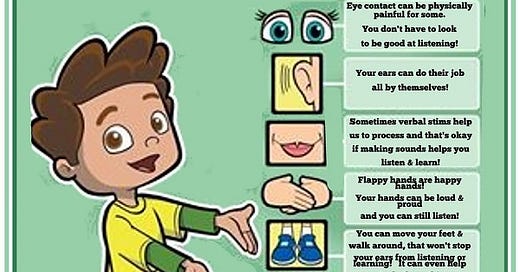Active listening - the autistic version
As we approach the halfway point of the first semester of US schools, teachers are engaged in data analysis in defense of the grades they’ve issues. One of the recommendations that administrators reflexively give to teachers is that their students should “actively listen.” The administrators often share cute graphics like those below.
If you’re a regular reader of this space, you might have noticed the many problems with the advice given in the graphics. Yes, we’re still fighting ableism …
From the first graphic:
Eyes on the speaker? I have heard autistic adults explain, and I’ve said this myself, that looking into someone eye’s feels roughly the same as being pricked in the eyes with hot needles. How would this help increase comprehension? With autistic folx, it doesn’t. For some people, like me, struggling to maintain eye contact takes so much energy and attention that focusing on the directions or the task at hand becomes nearly impossible.
Still bodies and hands in lap or on the table? For many autistic people, movement actually enhances listening and learning, and forcing stillness actually causes learning to diminish.
Appropriate expressions? For many autistic people, the production of facial expressions is different that our neurotypical peers. Not showing an “appropriate facial expression,” combined with stimming, is often interpreted as disrespectful by those that do not understand autistic people. On the facial recognition side, students with alexithymia (but who are not necessarily autistic) have difficulty reading the faces of their teachers and peers.
From the second graphic, the concept featured there is “whole body listening.” What could possibly be wrong with that? Let’s see (source).
What’s the Problem With Whole Body Listening? The ableist character, Listen Larry used to shame autistic people about whole body listening. The above image of a cartoon boy presenting a list of body parts with this text:
Eye contact can be physically painful for some. You don’t have to look to be good at listening!
Your ears can do their job all by themselves!
Sometimes verbal stims help us to process and that’s okay if making sounds helps you listen & learn!
Flappy hands are happy hands!
Your hands can be loud & proud and you can still listen!You can move your feet & walk around, that won’t stop your ears from listening or learning! It can even help you to do those things!
Your body is yours and you can move it however you need to. Your boundaries
are just as important as anybody else’s!Your brain is always thinking, even when others do not understand! Your brain is awesome exactly as it is!
Your heart is caring about others, and you deserve the same in return!
The graphic’s text ends with the following quote, “Ableist Larry is working on his ableist assumptions about Autistic people! Share this poster with others to help them learn too!”
A final thought. When administrators mindlessly share these ableist memes, they assume not only that there is a “standard learner,” but also that there is a “standard employee.” I have long since lost count of the professional spaces and programs where I’ve been that were designed with the assumption that people like me, autistic people, would not be present. Imagine that.








